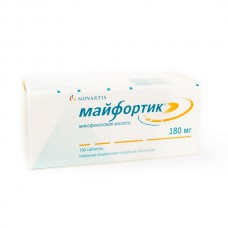Expiration date: 10/2027
Composition and form of release:
Tablets coated with a shell soluble in the intestine 1 table.
sodium mycophenolate 192.40 mg or 384.80mg
(equivalent to mycophenolic acid 180mg or 360mg)
excipients: anhydrous lactose crospovidone povidone (K30) corn starch silicon dioxide colloidal magnesium stearate
shell composition: shell: hypromellose phthalate, titanium dioxide (No77891, E171), iron oxide yellow (No77492, E172) indigocarmine (E132).
Description of the dosage form:
coated tablets with an intestinal-soluble shell of light green color, round, with beveled edges and marked "C" on one side.
Description of pharmacological action:
The drug Myfortic inhibits the synthesis of guanosine nucleotides by selectively suppressing the key enzyme of purine synthesis — inosine monophosphate dehydrogenase. Due to this mechanism, it effectively suppresses the proliferation of T and B lymphocytes, and to a much greater extent than other cells, since lymphocyte proliferation depends mainly on the synthesis of purines de novo.
Suppression of the proliferation of T and B lymphocytes by the drug Myfortic complements the action of calcineurin inhibitors that disrupt cytokine production and affect T lymphocytes in the resting phase of the cell cycle.
Indications:
Prevention of acute graft rejection in patients with allogeneic kidney transplants receiving basic immunosuppressive therapy with cyclosporine in the form of microemulsion and glucocorticosteroids.
Contraindications:
- hypersensitivity to mycophenolate sodium, mycophenolic acid, mycophenolate mofetil or any component of the drug.
- children's age (efficacy and safety have not been studied)
With caution:
- congenital deficiency of hypoxanthinguanine phosphoribosyltransferase (including Lesh-Nyhan and Kelly-Sigmiller syndromes)
- gastrointestinal diseases in the acute phase.
Use in children
The efficacy and safety of the drug Myfortic in children have not been studied. There is limited data on pharmacokinetics in children who have undergone kidney transplantation. At the moment, specific recommendations on the dosage regimen in children have not been developed.
Use during pregnancy and lactation:
When using the drug Myfortic during pregnancy, there was an increased risk of developing congenital anomalies. According to the American National Pregnancy Registry, in women after transplantation (National Transplant P®nancy Registry, NTPR), the average incidence of birth defects in children born to women who have undergone organ transplantation is 4-5%. Although controlled clinical studies on the use of the drug Myfortic in pregnant women have not been conducted, according to NTPR, when using mycophenolate mofetil in combination with other immunosuppressants during pregnancy, an increased incidence of congenital malformations was noted — 22% (4 children out of 18 newborns) compared with the average frequency. Most often, when using mycophenolate mofetil during pregnancy, abnormalities in the development of the inner ear, extremities, craniofacial region, including cleft upper lip and palate, congenital diaphragmatic hernias and heart defects were noted in children. When taken orally or intravenously, mycophenolate mofetil is converted into mycophenolic acid.
In experimental preclinical studies in animals, the teratogenic effect of mycophenolic acid was observed.
The administration of the drug Myfortic during pregnancy is possible only if the expected effect of therapy exceeds the possible risk to the fetus.
It is not recommended to start therapy with Myfortic before a negative pregnancy test result is obtained. In case of pregnancy, the patient should immediately consult a doctor.
Effective contraceptive methods should be used before starting therapy with Myfortic, throughout the entire therapy and for 6 weeks after its completion.
It is unknown whether IFC is excreted in breast milk. Due to the fact that there is a potential risk of serious adverse events in a breastfed child under the influence of sodium mycophenolate, it is necessary to resolve the issue of either discontinuing the use of the drug Myfortic, or, given the importance of therapy with this drug for the mother, discontinuing breastfeeding throughout therapy and within 6 weeks after its discontinuation.
Method of administration and dosage:
Inside, swallowing whole, without chewing, without breaking, on an empty stomach or with food.
Therapy with Myfortic in patients who have not received it before begins in the first 48 hours after transplantation. The recommended dose is 720 mg (4 tables. in an intestinal soluble shell of 180 mg or 2 tablets of 360 mg) 2 times a day (daily dose — 1440 mg). In patients receiving mycophenolate mofetil at a dose of 2 mg, MMF can be replaced with the drug Myfortic at a dose of 720 mg 2 times a day.
Use in elderly patients. Correction of the dosage regimen in elderly patients is not required.
Use in patients with impaired renal function. In patients with delayed recovery of renal graft function, a dose change of Myfortic is not required. Careful monitoring of patients with chronic severe renal impairment is necessary (glomerular filtration rate is less than 25 ml/min-1? 1, 73 m2).
Use in patients with impaired liver function. In patients with severe liver disease associated with a predominant lesion of the parenchyma, dose adjustment of the drug Myfortic is not required.
Episodes of rejection reaction. The graft rejection reaction does not lead to a change in the pharmacokinetics of IFC. In these cases, there is no need to change the dosage regimen.
Overdose:
There were no cases of overdose when using the drug Myfortic. Although the inactive metabolite of GMFC is eliminated by hemodialysis, it should not be expected that this method will effectively remove clinically significant amounts of active IFC. This is largely due to the high degree (97%) of binding of IFC to plasma proteins. Colestyramine and other bile acid sequestrants disrupt the absorption of IFC from the intestine and, therefore, can lead to a decrease in its concentration in the blood.


